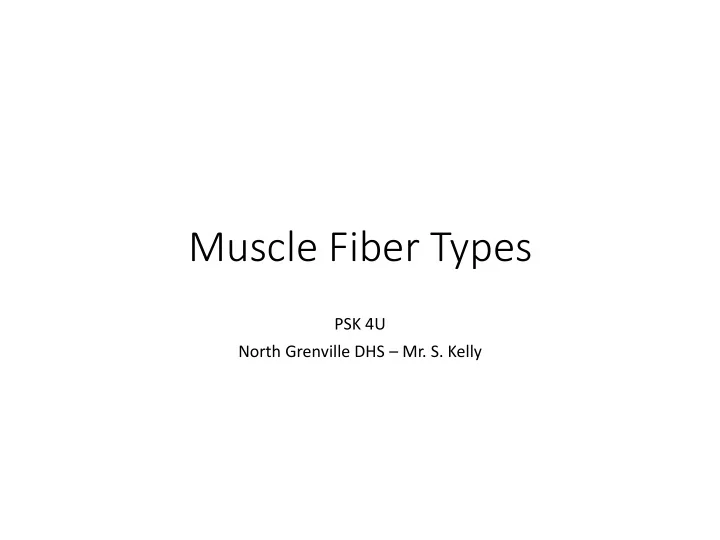

Muscle Fiber Types PSK 4U North Grenville DHS – Mr. S. Kelly
Slow Twitch Muscle Fibers • Darker (red) in colour • Contract and relax relatively slowly • Able to maintain low(er) tension for a longer period of time • Low levels of glycolytic enzymes • High levels of oxidative enzymes • Low levels of myosin ATPase (used to provide instant energy for muscle contractions) • Most active in endurance sports
Fast Twitch Muscle Fibers • More pale in colour • Ability to contract and relax quickly • High tension over short time period • High levels of myosin ATPase • Activate 2x or 3x faster than ST fibres • Most active in power sports • Question: are turkeys walkers or fliers? Without seeing a live one, how would you know?
The Muscle Biopsy • Used to determine muscle fibre type 1. Injection of local anesthetic into the muscle being sampled 2. Incision of approximately 5-7mm is made in the skin and fascia of the muscle 3. The piece of tissue (250-300mg) removed via the biopsy needle and is imbedded in a compound 4. The sample is frozen in isopentane cooled to – 180C
Application of The Muscle Biopsy
Why does muscle fiber type matter? • Most research suggests sport performance is due more to genetics (how we’re built) than genetics + training • Generally: endurance training can help FT fibers and strength training can make ST fibers stronger but NOT switch • Exception: when some spinal nerves are severed, fibers revert to FT
Determinant Method 1: Muscle Histochemistry • The biopsy samples are first sectioned (8-10 μ m thickness) • Sections are processed for myosin ATPase: Fast twitch fibres – rich in myosin ATPase (alkaline labile → inactivated or destroyed by high pH conditions) Slow twitch fibres – low in myosin ATPase (acid labile → inactivated or destroyed by low pH conditions) -Staining the of the muscle fibres indicates difference in myosin ATPase concentration -Sections are processed for other metabolic characteristics
Myosin ATPase • Enzyme used for breaking down ATP to fuel muscle contraction • Catalyst for: ATP + H 2 O → ADP + P **Chemical reaction is for ATP hydrolysis • At the cellular level, ATP binding and protein activity is called the “ powerstroke cycle”
Determinant Method 2: MHC (myosin heavy chain) Isoform Identification • Motor protein of thick (myosin) filaments • Similar proteins with a similar but not identical amino acid sequence • Site of myosin ATPase interaction • Version of myosin heavy chain isoform determines speed of ATP hydrolysis, indicating type of muscle fibre • Multiple muscle fibre types possible in same muscle.
Determinant Method 3: Biochemical ID of metabolic enzymes • Combines results of muscle histochemistry with analysis of enzymes involved in energy metabolism • Scott et al (2001) used this process to essentially classify fibres into: I. Fast twitch glycolytic II. Fast twitch oxidative III. Slow twitch oxidative
Myoglobin (review?) • Oxygen storage unit • Delivers oxygen to working muscles • Muscle fibres with high levels of myoglobin are designed for endurance activities • Muscle fibres with low levels of myoglobin are designed for power activities (short term)
Recall Neuromuscular Lesson? • Three criteria to determine muscle structure and function: 1. Transmission of action potential 2. Release of calcium 3. Attachment/detatchment of myosin and actin filaments - Fast-twitch fibres perform these tasks more quickly and efficiently.
How does this apply to sports? • Soccer (FC Copenhagen) study: fastest players are desired • Problem: fastest players often succumb to (semi-serious) injury before reaching the highest level of development (overtraining) • Solution: LESS training is the proper prescription for some athletes…
Type I: Slow Oxidative • Generate energy more slowly • More fatigue resistant • Primarily aerobic
Type IIA: Fast Oxidative-Glycolytic • Intermediate type of fibres • High speed energy release • Some glycolytic capacity
Type IIB (IIX): Fast Glycolytic • Store high levels of glycogen • High levels of enzymes allowing quick anaerobic contractions • Important: training can transform type IIX fibres to type IIA fibres • Type IIA fibres cannot become Type I fibres
Tonic Muscles • High percentage of Type I fibres • Involved in maintaining stability and posture • Ex: soleus
Phasic Muscles • Higher percentage of Type II (A and X) fibres • Used for powerful movements • Low conc of Type I fibres • Ex: quadriceps • NOTE: a muscle biopsy (see previous) can determine the ratio of fast- to slow-twitch muscle fibres • FT (IIB) fibers contract about twice as fast as ST
Questions and Application • Why is it important to know (even roughly) the ratio of FT to ST muscle fibres in an athlete? • How can this knowledge translate to greater success? • Does an athlete need to know this information? Would it help if he or she had this knowledge? Why (not)? • Think of a specific example or situation where this information would be important from an athletic training standpoint
Recommend
More recommend